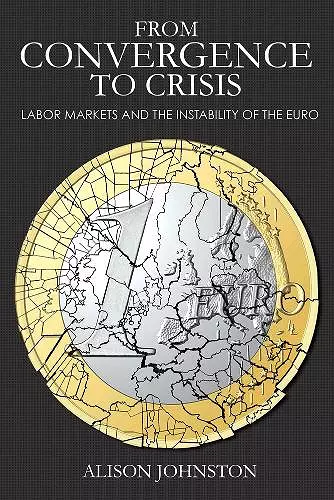From Convergence to Crisis
Labor Markets and the Instability of the Euro
Format:Hardback
Publisher:Cornell University Press
Published:16th Jun '16
Currently unavailable, and unfortunately no date known when it will be back

What explains Eurozone member-states’ divergent exposure to Europe’s sovereign debt crisis? Deviating from current fiscal and financial views, From Convergence to Crisis focuses on labor markets in a narrative that distinguishes the winners from the losers in the euro crisis. Alison Johnston argues that Europe’s monetary union was structured in a way that advantaged the corporatist labor markets of its northern economies in external trade and financial lending. Northern Europe’s distinct economic advantage lay not with its fiscal capabilities, which were not that different from those of southern Eurozone countries, but with its wage-setting institutions. Through highly coordinated collective bargaining, the euro North persistently undercut the inflation performance of southern trading partners, destining them to a perpetual cycle of competitive decline and external borrowing. While northern Europe’s corporatist labor markets were always low inflation performers, monetary union ultimately made their wage-setting institutions toxic for the South.
The euro’s institutional predecessor, the European Monetary System, included economic and institutional mechanisms that facilitated macroeconomic adjustment and convergence between the common currency’s corporatist and noncorporatist economies. Combining cross-national statistical analysis with detailed qualitative case studies of Denmark, Germany, Italy, Ireland, the Netherlands, and Spain, Johnston reveals that monetary union’s removal of these mechanisms allowed external imbalances between these two blocs to grow unchecked, underpinning the crisis in which Europe currently finds itself. Rather than achieving the EU’s goal of an ever-closer union, the common currency produced a monetary environment that destabilized the economic integration of its diverse labor markets.
Johnston uses theory, statistical analysis, and case studies to argue that each country's relative wage moderation compared to other European Monetary Union (EMU) members determines how susceptible the country has been to the debt crisis. The case studies analyze wage negotiation changes in Denmark, the Netherlands, Germany, Italy, Ireland, and Spain, mostly focusing on 1979 to 2008. Finally, Johnston argues, post-2008 austerity conditions for loans to countries on the verge of default have tended to exacerbate declines. She suggests supranational wage coordination and wage increases in creditor EMU nations to promote recovery. Summing Up: Recommended. Upper-division undergraduates through faculty.
-- E. J. Peterson * Choice *[This book] examines the European debt crisis, the effects of labor-market politics before the 2008 global financial crisis, and how the European Economic and Monetary Union (EMU) created circumstances that economically advantaged low-inflation northwest European member economies over high-inflation peripheral economies. [Johnston] presents a labor-market approach that views the euro crisis as a holistic problem and delineates the role of the EMU North in crisis recovery and in providing a solidaristic approach to EU recovery.
* Journal of Economic Literature *Johnston's book traces the development of wage rate bargaining institutions over time and across member states of the European Economic and Monetary Union (EMU). Her argument is as intuitive as it is compelling.
-- Ari Ray, University of Zurich * EuropeN- Winner of European Union Studies Association Book Prize 2017
- Winner of International Political Economy Annual Best Book Award.
ISBN: 9781501702655
Dimensions: unknown
Weight: 454g
248 pages